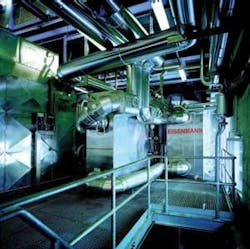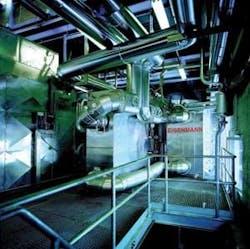New Thermal Biosolids Treatment System Introduced to US Market
Thermal treatment systems for municipal wastewater biosolids have been around for a long time but implementing this technology cost effectively for smaller plant operators has been challenging in the past.
Driven by current increased energy costs and tightening regulations, Eisenmann has developed the Pyrobustor® system for biosolids thermal treatment and energy recovery. With two successful installations in Europe, the company is now introducing the technology to the US. Designed for biosolids generators of approximately 1 ton/hour (dry solids), the system will allow operators of smaller facilities to realize the benefits of on site thermal treatment previously only affordable to much larger plants.
The Pyrobustor is a two-stage process, using pyrolysis in a proprietary rotary drum followed by a post combustion system. Biosolids, sludge and other organic waste is pyrolytically transformed into an energy-rich gas. The residual non-volatile ash is suited for disposal in landfills as a non-hazardous material. Depending on local market needs, the ash can also be used as filler for road construction, concrete products or similar applications.
Designed to treat biosolids streams up to one dry ton per hour, the system is ideally sized for many regional municipalities with biosolids disposal challenges. The system works in conjunction with a dryer to provide a 10:1 volume or mass reduction of dewatered biosolids. Waste heat from the Pyrobustor can be recovered for use by the dryer system or used to generate steam or “renewable” electrical power. Carbon credits may be generated from the reduction in emissions from transportation of the biosolids, and from generation of electrical power.
Case Study
The first Pyrobustor installation for thermal treatment of biosolids is in the Pustertal valley in South Tyrol, Italy. The regional treatment plant was constructed in 1996 inside Tobl Mountain. The facility treats residential wastewater from an association of (then) 14 municipalities with a collection area of 444 square miles.
Installed and optimized in 2005, the thermal treatment system has been in continuous operation since the beginning of 2006.
The installed system converts dry sludge pellets with a calorific value of up to 5,160 Btu/lb and 10-20% residual moisture into ash in a continuous process sized for a throughput of 1200 lb/h with 7,500 hours of operation per year. Fully automatic operations are controlled by a PLC system and monitored via PC plant visualization.
The dry sludge pellets are fed into the Pyrobustor® from a storage container by a screw conveyor. The pellets are first pyrolyzed and then oxidized into inert ash. With just 8–10% of the original weight (compared to mechanically dewatered sludge), the ash is used as filler at a nearby brick-production facility.
The energy side of this technical approach is net positive. The liberated heat of combustion from the sludge is used first to heat the thermal oil for heating the sewage sludge drier. Then it is used to heat the process water for preheating the air of the drier. This concept yields savings of up to 65% in relation to the primary energy previously needed for the drying process. In 2008 plant operators replaced the outdated dryer/pelletizer system with a new convection belt dryer system further improving the overall energy balance and performance of the system. WW

